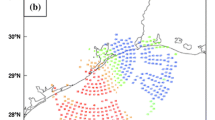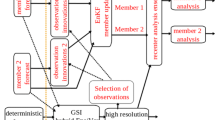Abstract
The impact of deploying a flow-dependent ensemble error covariance in Weather Research and Forecasting (WRF) three-dimensional variational (3DVAR) data assimilation (DA) system is examined for short-range rainfall forecasts during an Indian summer monsoon season. The flow-dependent background error covariance (BEC) is generated using a 50-member ensemble, which is further updated using the ensemble transform Kalman filter (ETKF). Assimilation is performed using a Hybrid variational-ensemble (“Hybrid”) and traditional 3DVAR DA system during the 4 weeks of July 2013. The forecasted wind, temperature, and rainfall from the assimilation experiments are verified against corresponding observations. The results indicate that the flow-dependent ensemble background error covariance in 3DVAR has systematically improved the forecasted wind and temperature when compared to the traditional 3DVAR. Similarly, rainfall forecast skill is superior in the Hybrid experiments relative to that of 3DVAR. Convection-permitting resolution rainfall forecast is validated against 746 telemetric rain gauge observations over the state of Karnataka. The Hybrid experiments show higher quantitative precipitation forecast skill than 3DVAR, particularly towards the later stages of data assimilation cycling. Spatially, the 3DVAR experiment shows a dry bias over the upper peninsular regions and a slight wet bias over the central and the northern Indian regions, while the magnitude of such wet and dry biases is smaller in forecasts from Hybrid analysis. Additionally, the westerly wind over the peninsular Indian landmass analyzed by 3DVAR is considerably weaker than that analyzed by the Hybrid experiments. This is proposed as a possible reason for the reduced dry bias in rainfall forecasts over the Indian landmass in Hybrid versus 3DVAR experiments.













Similar content being viewed by others
References
Barker, D. M., Huang, W., Guo, Y.-R., Bourgeois, A., & Xiao, Q. (2004). A three-dimensional variational data assimilation system for MM5: Implementation and initial results. Monthly Weather Review, 132, 897–914.
Buehner, M. (2005). Ensemble-derived stationary and flow-dependent background-error covariances: Evaluation in a quasi-operational NWP setting. Quarterly Journal of the Royal Meteorological Society, 131, 1013–1043.
Dhanya, M., & Chandrasekar, A. (2016). Impact of variational assimilation using multivariate background error covariances on the simulation of monsoon depressions over India. Annales Geophysicae, 34(2), 187–201. https://doi.org/10.5194/angeo-34-187-2016.
Evensen, G. (2003). The ensemble Kalman filter: Theoretical formulation and practical implementation. Ocean Dynamics, 53, 343–367.
Findlater, J. (1978). Observational aspects of the low-level cross-equatorial jet stream of the western Indian Ocean Monsoon Dynamics (pp. 1251–1262). Berlin: Springer.
Hamill, T. M., & Snyder, C. (2000). A hybrid ensemble Kalman filter-3D variational analysis scheme. Monthly Weather Review, 128, 2905–2919.
Hamill, T. M., Whitaker, J. S., & Snyder, C. (2001). Distance-dependent filtering of background error covariance estimates in an ensemble Kalman filter. Monthly Weather Review, 129, 2776–2790.
Houtekamer, P. L., & Mitchell, H. L. (2001). A sequential ensemble Kalman filter for atmospheric data assimilation. Monthly Weather Review, 129, 123–137.
Jiang, X., Li, T., & Wang, B. (2004). Structures and mechanisms of the northward propagating boreal summer intraseasonal oscillation. Journal of Climate, 17, 1022–1039.
Kalnay, E. (2003). Atmospheric modeling, data assimilation and predictability. Cambridge: Cambridge University Press.
Kleist, D. T., & Ide, K. (2015). An OSSE-based evaluation of hybrid variational–ensemble data assimilation for the NCEP GFS. Part I: System description and 3D-hybrid results. Monthly Weather Review, 143, 433–451.
Kleist, D. T., Parrish, D. F., Derber, J. C., Treadon, R., Wu, W.-S., & Lord, S. (2009). Introduction of the GSI into the NCEP global data assimilation system. Weather and Forecasting, 24, 1691–1705.
Ku, J., Kutty, G., & George, B. (2020). On the predictability and dynamics of tropical cyclone: Nargis (2008). Journal of Geophysical Research: Atmospheres. https://doi.org/10.1029/2019JD032040.
Kumar, P., Singh, R., Joshi, P., & Pal, P. (2011). Impact of additional surface observation network on short range weather forecast during summer monsoon 2008 over Indian subcontinent. Journal of Earth System Science, 120, 53–64.
Kutty, G., Muraleedharan, R., & Kesarkar, A. P. (2018). Impact of representing model error in a hybrid ensemble-variational data assimilation system for track forecast of tropical cyclones over the Bay of Bengal. Pure and Applied Geophysics, 175, 1155–1167.
Kutty, G., & Wang, X. (2015). A comparison of the impacts of Radiosonde and AMSU radiance observations in GSI based 3DEnsVar and 3DVar data assimilation systems for NCEP GFS. Advances in Meteorology. https://doi.org/10.1155/2015/280546.
Lorenc, A. C. (2003). The potential of the ensemble Kalman filter for NWP—A comparison with 4D-Var. Quarterly Journal of the Royal Meteorological Society, 129, 3183–3203.
Pai, D., Sridhar, L., Badwaik, M., & Rajeevan, M. (2015). Analysis of the daily rainfall events over India using a new long period (1901–2010) high resolution (0.25 × 0.25) gridded rainfall data set. Climate Dynamics, 45, 755–776.
Parrish, D. F., & Derber, J. C. (1992). The National Meteorological Center’s spectral statistical-interpolation analysis system. Monthly Weather Review, 120, 1747–1763.
Prasad, V., Johny, C., & Sodhi, J. S. (2016). Impact of 3D Var GSI-ENKF hybrid data assimilation system. Journal of Earth System Science, 125, 1509–1521.
Rajeevan, M., Bhate, J., & Jaswal, A. K. (2008). Analysis of variability and trends of extreme rainfall events over India using 104 years of gridded daily rainfall data. Geophysical Research Letters. https://doi.org/10.1029/2008GL035143.
Rakesh, V., & Goswami, P. (2011). Impact of background error statistics on forecasting of tropical cyclones over the north Indian Ocean. Journal of Geophysical Research: Atmospheres, 1, 1. https://doi.org/10.1029/2011JD015751.
Rakesh, V., & Goswami, P. (2015). Impact of data assimilation on high-resolution rainfall forecasts: A spatial, seasonal, and category analysis. Journal of Geophysical Research: Atmospheres, 120, 359–377.
Rakesh, V., Singh, R., Pal, P., & Joshi, P. (2009). Impacts of satellite-observed winds and total precipitable water on WRF short-range forecasts over the Indian region during the 2006 summer monsoon. Weather and Forecasting, 24, 1706–1731.
Routray, A., Mohanty, U., Das, A. K., & Sam, N. (2005). Study of heavy rainfall event over the west-coast of India using analysis nudging in MM5 during ARMEX-I. Mausam, 56, 107–120.
Routray, A., Mohanty, U., Osuri, K. K., Kar, S., & Niyogi, D. (2016). Impact of satellite radiance data on simulations of Bay of Bengal tropical cyclones using the WRF-3DVAR modeling system. IEEE Transactions on Geoscience and Remote Sensing, 54, 2285–2303.
Schaefer, J. T. (1990). The critical success index as an indicator of warning skill. Weather and Forecasting, 5, 570–575. https://doi.org/10.1175/1520-0434(1990)005%3c0570:tcsiaa%3e2.0.co;2.
Schwartz, C. S., Liu, Z., Huang, X. Y., Kuo, Y. H., & Fong, C. T. (2013). Comparing limited-area 3DVAR and hybrid variational-ensemble data assimilation methods for typhoon track forecasts: Sensitivity to outer loops and vortex relocation. Monthly Weather Review, 141(12), 4350–4372.
Skamarock, W. C., Klemp, J. B., Dudhia, J., Gill, D. O., Barker, D. M., Duda, M. G., & Powers, J. G. (2008). G.: A description of the Advanced Research WRF version 3. In NCAR Tech. Note NCAR/TN-475+ STR.
Speer, M., & Leslie, L. (2002). The prediction of two cases of severe convection: Implications for forecast guidance. Meteorology and Atmospheric Physics, 80, 165–175.
Wang, X. (2011). Application of the WRF Hybrid ETKF–3DVAR Data Assimilation System for Hurricane Track Forecasts. Weather and Forecasting, 26, 868–884. https://doi.org/10.1175/WAF-D-10-05058.1.
Wang, X., Barker, D. M., Snyder, C., & Hamill, T. M. (2008). A hybrid ETKF-3DVAR data assimilation scheme for the WRF model. Part I: Observing system simulation experiment. Monthly Weather Review, 136, 5116–5131.
Wang, X., & Bishop, C. H. (2003). A comparison of breeding and ensemble transform Kalman filter ensemble forecast schemes. Journal of the Atmospheric Sciences, 60, 1140–1158. https://doi.org/10.1175/1520-0469(2003)060%3c1140:acobae%3e2.0.co;2.
Wang, X., Parrish, D., Kleist, D., & Whitaker, J. (2013). GSI 3DVar-based ensemble–variational hybrid data assimilation for NCEP Global Forecast System: Single-resolution experiments. Monthly Weather Review, 141(11), 4098–4117.
Weisman, M. L., Skamarock, W. C., & Klemp, J. B. (1997). The resolution dependence of explicitly modeled convective systems. Monthly Weather Review, 125, 527–548.
Wilks, D. S. (2011). Statistical methods in the atmospheric sciences (Vol. 100). London: Academic Press.
Acknowledgements
The authors thankfully acknowledge the Indian Institute of Tropical Meteorology for providing us high-performance computing resources. The NCEP global forecast system analyses and forecast data utilized in this study are freely available in the repository https://rda.ucar.edu at https://doi.org/10.5065/D65Q4TSG. Data assimilation is performed using observations derived from NCEP ADP Global Upper Air and Surface Weather Observations archived in the https://rda.ucar.edu at https://doi.org/10.5065/Z83F-N512. ERA interim data used for validation of the model result can be accessed from https://rda.ucar.edu at https://doi.org/10.5065/D6CR5RD9.
Author information
Authors and Affiliations
Corresponding author
Additional information
Publisher's Note
Springer Nature remains neutral with regard to jurisdictional claims in published maps and institutional affiliations.
Electronic supplementary material
Below is the link to the electronic supplementary material.
Supporting Information: The ETS and bias-based skill scores of quantitative precipitation forecasts for 48 h are provided as supplementary information. Figure S1 and Figure S2 represent the ETS and bias for 48-h forecast for domain 1 and domain 3, respectively.
Rights and permissions
About this article
Cite this article
Gogoi, R.B., Kutty, G., Rakesh, V. et al. Comparison of the Performance of Hybrid ETKF-3DVAR and 3DVAR Data Assimilation Systems on Short-Range Forecasts during Indian Summer Monsoon Season in a Limited-Area Model. Pure Appl. Geophys. 177, 5007–5026 (2020). https://doi.org/10.1007/s00024-020-02537-6
Received:
Revised:
Accepted:
Published:
Issue Date:
DOI: https://doi.org/10.1007/s00024-020-02537-6




